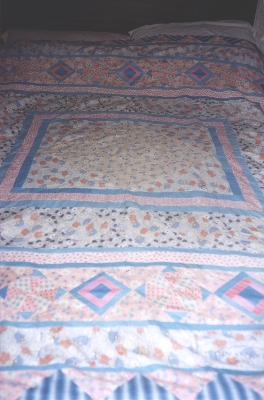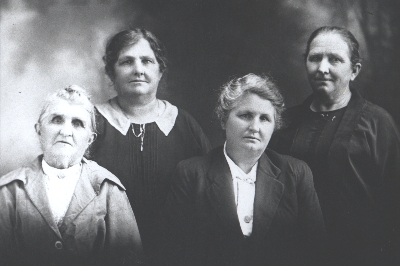Quilt No.932NC - Mrs Noleen Caarthew

2140 x 1850mm
The quilt top was made by Emma Jane Loder (born Lloyd) 1842 - 1938 between 1920 and 1930. Emma made many quilts in her lifetime. It has been passed down in the family and is now owned by Mrs. Noleen Carthew (born Beasley) great grand-daughter of the maker.
Emma was born in 1842 in SA and went to the Coolgardie gold fields with her daughter Mrs. N.C.Bottrill (born Loader) and their children (and a cocky and a galah) to join their husbands. They saw the New Year of 1896 in outside Bulla Bullin where the coach had broken down. They eventually arrived at Coolgardie and the women had to finish constructing the house they were to live in.
"My husband was working in the mine, but all the house he had for us to live in was some large sheets of iron leaning against a large log and the first thing I had to do was to cut some poasts and dig holes and put them in the ground, then cut corn sacks open and sew them together and nail them to the poast then put the iron on it for a roof and sewed more bags up and lined it inside too, then got some big cases from the store ' there was always plenty of cases to be got which the goods came up in' and made doors and window frames and put some micha 'from the micha mine which was about 3 or 4 miles away' and put micha in for glass, then I papered the inside with newspapers and whitewashed the outside, it was quite a smart house. I pugged the floors to make them hard and sewed bags together for carpets, then I started making the furniture, I made bedsteads, tables, sofas, chairs and cupboard all out of boxes and had a comfortable home. I got the storekeeper to get me a Metters stove then I found I had to put in some poast, a few feet from the house and nail nails on them to keep the horses and camels from breaking the house. I also made a garden and in the winter I had plenty nice vegetables, but the water was too dear and scarce in the summertime, it was then 1/- for a kerosene bucket full of condensed water, and only allowed to have one bucket a day, and if the thunder storm came up, we put everything that would hold water, around the house to catch the droppings from the roof, even the jam tins.
During my stay in Western Australia I made quite a number of different homes like that but as the trains got going on the fields and we could get iron cheaper, we made the walls of iron and boxes made into board floors and I built a brick chimney for my stove and lined the inside of the iron walls with oilcloth and had linoes on the floors (quite smart then)."
[Extract reminiscences of Emma Jane Loader 1938 courtesy Noleen Carthew and David Beasley Adelaide]

Related Quilts:
1625 x 925mm
2109 x 1702mm
1820 x 1680mm
1790 x 1750mm
2211 x 1752mm






